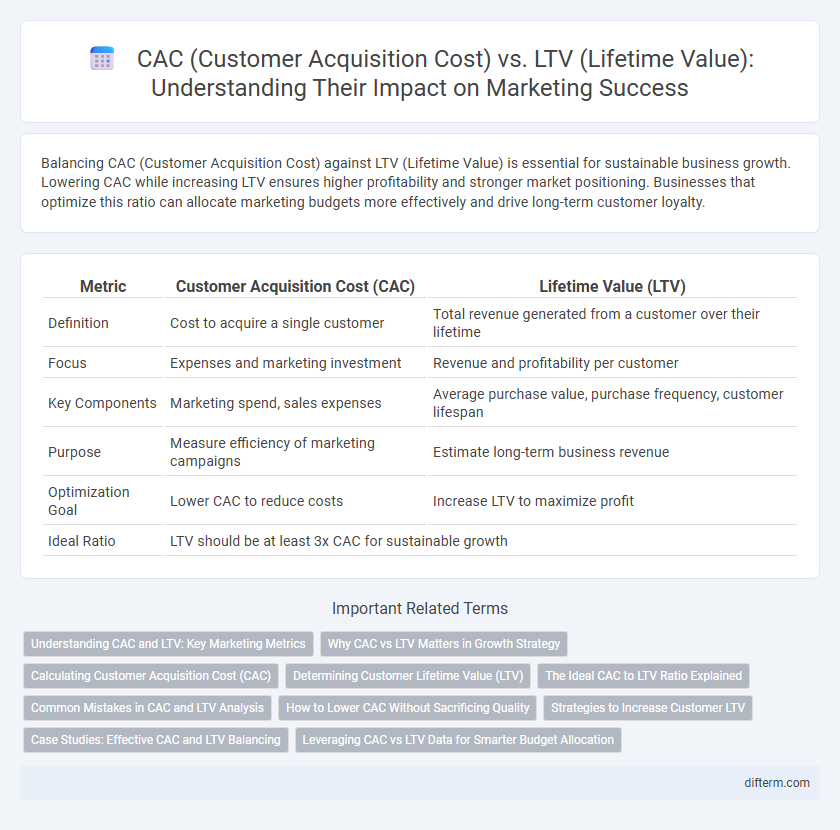Balancing CAC (Customer Acquisition Cost) against LTV (Lifetime Value) is essential for sustainable business growth. Lowering CAC while increasing LTV ensures higher profitability and stronger market positioning. Businesses that optimize this ratio can allocate marketing budgets more effectively and drive long-term customer loyalty.
Table of Comparison
| Metric | Customer Acquisition Cost (CAC) | Lifetime Value (LTV) |
|---|---|---|
| Definition | Cost to acquire a single customer | Total revenue generated from a customer over their lifetime |
| Focus | Expenses and marketing investment | Revenue and profitability per customer |
| Key Components | Marketing spend, sales expenses | Average purchase value, purchase frequency, customer lifespan |
| Purpose | Measure efficiency of marketing campaigns | Estimate long-term business revenue |
| Optimization Goal | Lower CAC to reduce costs | Increase LTV to maximize profit |
| Ideal Ratio | LTV should be at least 3x CAC for sustainable growth | |
Understanding CAC and LTV: Key Marketing Metrics
Customer Acquisition Cost (CAC) measures the total expense incurred to acquire a new customer, encompassing marketing and sales investments. Lifetime Value (LTV) quantifies the total revenue a business expects from a single customer throughout their relationship. Understanding the balance between CAC and LTV is essential for optimizing marketing strategies and ensuring sustainable profitability.
Why CAC vs LTV Matters in Growth Strategy
Balancing Customer Acquisition Cost (CAC) against Lifetime Value (LTV) is crucial in growth strategy to ensure sustainable profitability. A lower CAC compared to LTV indicates efficient marketing spend, driving higher returns on investment and scalable expansion. Monitoring this ratio helps businesses optimize resource allocation, reduce churn, and maximize long-term revenue growth.
Calculating Customer Acquisition Cost (CAC)
Calculating Customer Acquisition Cost (CAC) involves dividing the total marketing and sales expenses by the number of new customers acquired during a specific period, providing a clear metric for evaluating acquisition efficiency. This calculation includes costs such as advertising spend, salaries, software, and overhead tied directly to customer acquisition efforts. Accurate CAC measurement enables businesses to optimize marketing budgets and align acquisition strategies with customer Lifetime Value (LTV) to ensure sustainable growth.
Determining Customer Lifetime Value (LTV)
Customer Lifetime Value (LTV) measures the total revenue a business can expect from a single customer throughout their relationship. Calculating LTV involves analyzing average purchase value, purchase frequency, and customer retention rate to predict future revenue streams. Accurate LTV determination enables marketers to balance CAC effectively, ensuring sustainable growth and improved ROI.
The Ideal CAC to LTV Ratio Explained
The ideal CAC to LTV ratio is generally accepted as 1:3, indicating that the lifetime value of a customer should be three times the cost of acquiring them. This 3:1 ratio ensures profitability and sustainable growth by maximizing customer value while minimizing acquisition costs. Businesses monitoring this ratio can effectively allocate marketing budgets and optimize customer acquisition strategies for long-term success.
Common Mistakes in CAC and LTV Analysis
Common mistakes in CAC and LTV analysis include underestimating hidden costs such as onboarding and churn impacts, leading to inaccurate customer acquisition cost calculations. Overlooking variations in customer segments causes LTV projections to be overly generalized, reducing their predictive validity. Ignoring the timing of cash flows and failing to update models regularly results in skewed ROI assessments and misinformed marketing strategies.
How to Lower CAC Without Sacrificing Quality
Lowering Customer Acquisition Cost (CAC) without sacrificing quality requires optimizing marketing channels through data-driven targeting and personalized campaigns that enhance conversion rates. Leveraging customer lifetime value (LTV) insights allows marketers to prioritize high-value segments, ensuring spending efficiency and better ROI. Investing in brand reputation and referral programs increases organic growth, reducing CAC while maintaining customer quality and loyalty.
Strategies to Increase Customer LTV
Maximizing customer lifetime value (LTV) requires implementing personalized marketing strategies, upselling and cross-selling techniques, and enhancing customer engagement through loyalty programs. Investing in data-driven segmentation and tailored content boosts retention rates and encourages repeat purchases, ultimately improving LTV relative to customer acquisition cost (CAC). Efficient allocation of budget toward customer success initiatives reduces churn and increases overall profitability by extending the revenue generated per customer over time.
Case Studies: Effective CAC and LTV Balancing
Case studies reveal that brands achieving a healthy balance between Customer Acquisition Cost (CAC) and Lifetime Value (LTV) prioritize tailored marketing strategies and efficient channel allocation. By optimizing CAC through targeted campaigns and enhancing LTV via personalized customer experiences, companies like Amazon and Netflix have sustained scalable growth. Analyzing these success stories highlights the critical role of data-driven decision-making to maximize profitability and long-term customer engagement.
Leveraging CAC vs LTV Data for Smarter Budget Allocation
Analyzing Customer Acquisition Cost (CAC) alongside Lifetime Value (LTV) enables marketers to identify the most profitable customer segments and tailor budget allocation accordingly. Businesses with a high LTV to CAC ratio can confidently invest more in marketing channels that yield valuable long-term customers. Leveraging detailed CAC vs LTV metrics optimizes spending decisions, improves ROI, and drives sustainable growth.
CAC (customer acquisition cost) vs LTV (lifetime value) Infographic

 difterm.com
difterm.com